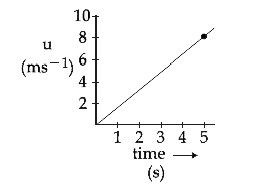Theposition vector of a moving particle at time t is r=3ˆi+4tˆj−tˆk Its displacement during the time interval t=1 s to t=3 s is
ˆj−ˆk
3ˆi+4ˆj−ˆk
9ˆi+36ˆj−27ˆk
None of the above
The correct Answer is:D
To find the displacement of the moving particle during the time interval from t=1 s to t=3 s, we will follow these steps:
Step 1: Determine the position vector at t=3 s
The position vector r is given by:
r=3^i+4t^j−t^k
Substituting t=3 s:
r3=3^i+4(3)^j−(3)^k
Calculating this gives:
r3=3^i+12^j−3^k
Step 2: Determine the position vector at t=1 s
Now substituting t=1 s into the position vector:
r1=3^i+4(1)^j−(1)^k
Calculating this gives:
r1=3^i+4^j−1^k
Step 3: Calculate the displacement
Displacement D is given by the difference of the final and initial position vectors:
D=r3−r1
Substituting the values we calculated:
D=(3^i+12^j−3^k)−(3^i+4^j−1^k)
This simplifies to:
D=(3^i−3^i)+(12^j−4^j)+(−3^k+1^k)
D=0^i+8^j−2^k
Thus, the displacement vector is:
D=8^j−2^k
Step 4: Check the options
Since the displacement 8^j−2^k does not match any of the provided options, we conclude that the correct answer is option 4: none of these.
---
The position vector r is given by:
r=3^i+4t^j−t^k
Substituting t=3 s:
r3=3^i+4(3)^j−(3)^k
Calculating this gives:
r3=3^i+12^j−3^k
Now substituting t=1 s into the position vector:
r1=3^i+4(1)^j−(1)^k
Calculating this gives:
r1=3^i+4^j−1^k
Displacement D is given by the difference of the final and initial position vectors:
D=r3−r1
Substituting the values we calculated:
D=(3^i+12^j−3^k)−(3^i+4^j−1^k)
This simplifies to:
D=(3^i−3^i)+(12^j−4^j)+(−3^k+1^k)
D=0^i+8^j−2^k
Thus, the displacement vector is:
D=8^j−2^k
Since the displacement 8^j−2^k does not match any of the provided options, we conclude that the correct answer is option 4: none of these.
Topper's Solved these Questions
Similar Questions
The position vector of a moving particle at't' sec is given by →r=3ˆi+4t2ˆj−t3ˆk . Its displacement during an interval of t = Is to 3 sec is
View SolutionCalculate impulse of force →F=(3t2ˆi−(2t−1)ˆj+2ˆk)N over the time interval from t=1s to t=3s.
View SolutionThe position of a particle moving on X-axis is given by
x=At3+Bt2+Ct+D.
The numerical values of A,B,C,D are 1,4,-2 and 5 respectively and I units are used. Find a. the dimensions of A,B, C and D b. the velocity of the particle at t=4s, the acceleration of he particle at t=4s, d. The average velocity during the interval t=0 to t=4s, the average accelerationduring the interval t=0 to t=4s.View SolutionThe position of a particle along X-axis at time t is given by x=2+t−3t2. The displacement and the distance travelled in the interval, t = 0 to t = 1 are respectively
View SolutionThe position of a particle moving along x-axis varies eith time t as x=4t−t2+1. Find the time interval(s) during which the particle is moving along positive x-direction.
View SolutionThe speed verses time graph for a particle is shown in the figure. The distance travelled (in m) by the particle during the time interval t = 0 to t = 5 s will be __________
 View Solution
View SolutionA particle is moving with a velocity of v=(3+6t+9t2)ms. Find out
(a) the acceleration of the particle at t=3s.
(b) the displacement of the particle in the interval t=5s to t=8s.View SolutionAt time t second, a particle of mass 3 kg has position vector r metre, where r=3tˆi−4costˆj. Find the impulse of the force during the time interval 0≤t≤π2
View SolutionAt time t second, a particle of mass 3 kg has position vector r metre, where r=3tˆi−4costˆj. Find the impulse of the force during the time interval 0≤t≤π2
View SolutionThe position of a particle varies with time according to the relation x=3t2+5t3+7t, where x is in m and t is in s. Find
(i) Displacement during time interval t = 1 s to t = 3 s.
(ii) Average velocity during time interval 0 - 5 s.
(iii) Instantaneous velocity at t = 0 and t = 5 s.
(iv) Average acceleration during time interval 0 - 5 s.
(v) Acceleration at t = 0 and t = 5 s.View Solution

